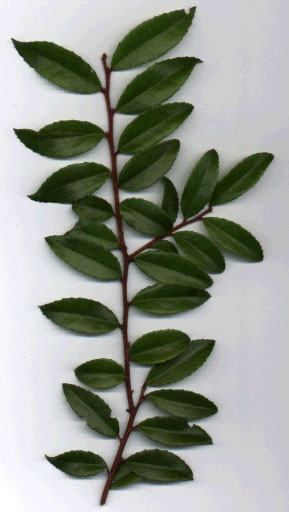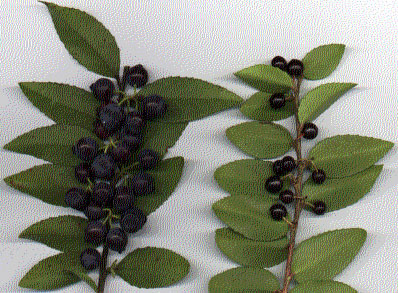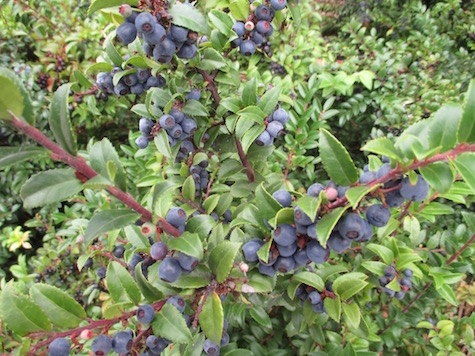Plant of the Month: January 2003
|
| Evergreen Huckleberry |
| Vaccinium ovatum Pursh |
ERICACEÆ; Heath Family
|
| Huckleberry shrubs can be deciduous or evergreen, and are related closely to blueberries, cranberries, lingonberries, whortleberries, farkleberries and bilberries. There are about 450 species of Vaccinium around the world. |
| Dense, dark evergreen foliage clothes this native shrub, which ranges from southeastern British Columbia into California. The berries, ripe from (August) September into January, are either shiny black or dull blue --the blue berries are larger (about a third of an inch), juicier, and better tasting. Though mostly found in shady woods among conifers, some evergreen huckleberry bushes grow on exposed Puget Sound bluffs. |
| From early April into June, the shrub produces inconspicuous white or pink-tinged flowers beneath the twigs; bees like them. It reaches about the same size (4 to 10 feet tall and wide) as red huckleberry (Vaccinium parvifolium), its more common deciduous cousin. The epithet ovatum is inapt, since the leaves are usually more elliptic than egg-shaped. Each leaf is thick and glossy, about half an inch to one-and-a-half inches long. When the tender young foliage is emerging in spring it is contrastingly bronzy or coppery colored. Florists use the attractive full-grown foliage for arrangements. |
| As a landscape plant, evergreen huckleberry offers year-round presence, shade tolerance, and edible berries. It can be used where one might otherwise plant boxwood or Japanese holly. It is especially valuable for planting beneath pines. How many other berry bushes can you choose from that can grow in dry shade? If planted out in the open, the foliage can take on a purplish cast. I think it should be planted in shade. Though easily raised from seed, it is slow growing, and transplant mortality is high. If you desire berries, plant several bushes together for best yields. |
| As for pests or diseases I have noticed only the occasional twig tip dying, and curious witches'-brooms caused by a rust. The witches'-brooms make the twigs become swollen and corky, and the twigs to be curled, coiled, and extraordinarily congested. This is caused by Pucciniastrum Goeppertianum, a needle rust of grand fir (Abies grandis). |
Other names include: box huckleberry or blueberry, California or coast huckleberry, black huckleberry, shot huckleberry, and evergreen blueberry.
Back
|

Evergreen Huckleberry foliage scan by ALJ
|

Evergreen Huckleberries scan by ALJ
|

Evergreen Huckleberries photo by ALJ
|
|
|

